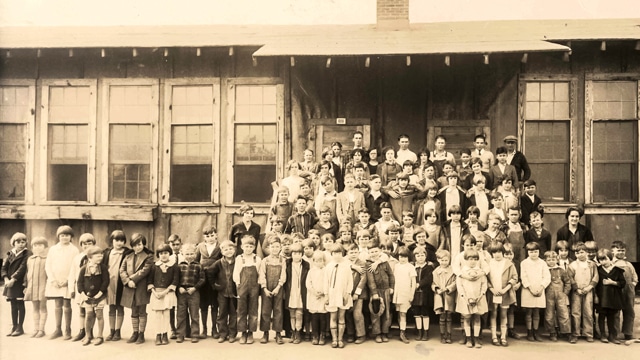Life in old Alabama Power villages getting second look

Jordan Dam schoolhouse and students, March 1, 1928. (Alabama Power Company Archives and Museum)
In the early 20th century, as Alabama Power built dams it also helped develop the state by investing in industry, and providing opportunities for jobs and a higher quality of life. The company’s early hydroelectric projects – Lay, Mitchell, Martin and Jordan – were so large that for many years they remained the most complex and expensive construction projects in state history.
The land where these projects arose was rough and remote, being many miles from the nearest cities. To muster and maintain the workforce necessary for construction, the company built temporary villages, with housing and dining halls. Some had amenities like hospitals and commissaries. As each construction project wound down, many of the workers stayed with the company, moving on to the next project.
Since the dams at that time required manual operation and 24-hour supervision, “permanent villages” with houses, recreation facilities and in some cases schools, were established for the workers and their families.
Village documentation
In the 1950s, as automobiles became more commonplace and technology allowed for automation, the need waned for villages at the hydroelectric dams and steam plants. Through the decades that followed, most of the buildings and houses were relocated, refurbished for other uses or torn down. Today, only a handful of the permanent village houses remain, and Alabama Power is working to document the history before it is lost.
Under Federal Energy Regulatory Commission (FERC) relicensing requirements, the company is completing historical assessments of hydroelectric sites more than 50 years old. Bill Gardner, an engineer in Environmental Affairs, has led the multi-phase assessments that begin with analysis of the significance of each dam and powerhouse.
“To do this, we gather internal documents, engineering records from reproduction graphics, and photographs and information from the Corporate Archives,” Gardner said. “Then, I use historic archival documents and photographs, and interviews and focus groups with former village residents, to learn about the village – the layout, use of the buildings over time, and the social and real-life stories of the people who grew up there.”

Finally, a cultural resource management firm is hired to perform archaeological and architectural assessments at the sites. These specialists compile a report using all the information collected and submit it to the Alabama Historical Commission, the agency that governs historic property management plans.
“Even though we looked at them (the dam and village) separately, they are tied together. The village wouldn’t be there but for the dam, and the dam couldn’t be built without the village,” Gardner said.
For Gardner, who has been with the company for 38 years, it’s more than just a job: it’s a passion.
“I’ve enjoyed being a longtime employee of the company … hearing the experiences of the people or their parents, that have worked at the company those generations, and taking pride that the company is over 100 years old,” Gardner said.
“I could walk away today and say that I made a difference,” he continued. “The work product will be self-sustaining.”
Jordan Dam
Jordan Dam is undergoing the second phase of assessment. Utilizing employee and word-of-mouth connections, Gardner has located about a dozen former residents of Jordan village. Several former villagers gathered at the company’s Wetumpka Business Office for a focus group before heading to the site of their former childhood homes.
For many of the villagers, it was their first time back to the dam since childhood.
“It was great to see some of my old friends that I haven’t seen in decades,” said Joe McDonald, whose father, Bross K. McDonald, was a plant operator. The late McDonald was responsible for taking hourly readings of the plant’s output and switching generators on or off as directed by central dispatch in Birmingham.
“It’s great that you’re documenting the history of the Jordan Dam village,” McDonald commented.
“The other villagers who were at the meeting are like family,” said Margaret Jones Barnett, whose father, Spike Jones, started with the company in the 1940s, first at Chickasaw, then transferring to Jordan. A welder and mechanic, Jones repaired the dam turbines.
“We grew up together, played together and partied in the village together. My sister, Patricia Jones Halladay, and I love to go back to the dam as often as we can,” Barnett said. “It always has a feeling of going back home. We go back and relive our childhood.”
Gardner hears a lot of similar sentiments. “In addition to going back to their childhood, it is also looking back at their parents, and having some pride that their parent had a job at the dam. Alabama Power was important,” Gardner said.
“This is the first time all of this information has been pulled together … and it’s one of these documents that will last,” he said.
Anyone with information, villager contacts or photographs of any of Alabama Power’s hydroelectric dams or steam plants is encouraged to visit the company’s archives. To share memories or photographs, contact Erin Harney, eeharney@southernco.com or 205-257-2095.












